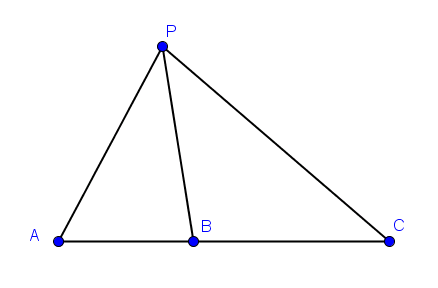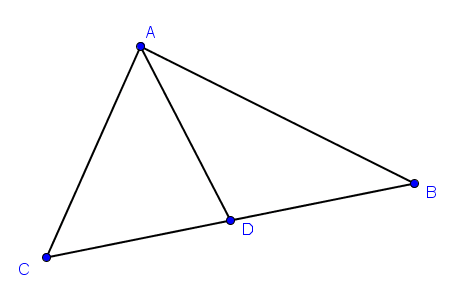In this topic I want to share relation of the Pythagorean theorem, the Stewart theorem and the British Flag theorem, the Apollonius' theorem, the Ptolemy's theorem and the Feuerbach-Luchterhand. Since that I posed two conjectures of generalizations of these theorems. My question: I am looking for get a solution of my conjecture.
I. Relation of some Euclidean geometry theorems
- Pythagorean theorem: Let $ABC$ For a right triangle with legs $AB$ and $AC$ and hypotenuse $BC$ then:
\begin{equation}AB^2+AC^2=BC^2 \end{equation}
- Apollonius' theorem in any triangle $ABC$, if $AD$ is a median, then
\begin{equation}AB^2 + AC^2 = 2(AD^2+BD^2)\end{equation}
- Let $ABC$ be Isosceles triangle with $AB=AC$. Apply Apollonius' theorem we have $AB^2=AD^2+BD^2$, in this case $AD \perp BC$. This is the Pythagorean theorem with the right triangle $ABD$. So the Apollonius' theorem is a generalization of the Pythagorean theorem.
- Stewart's theorem Let $A$, $B$, $C$ be points on a directed line $l$ in the Euclidean plane, and $P$ be a point anywhere in the plane. Then
\begin{equation}PA^2.\overline{BC} + PB^2.\overline{CA} + PC^2.\overline{AB} + \overline{BC}.\overline{CA}.\overline{AB} = 0\end{equation}

- Let $B$ is midpoint of $AC$ we have: $\overline{BC}=\overline{AB}$, $\overline{CA}=-2\overline{AB}$. Since Stewart's theorem we have:
\begin{equation}PA^2.\overline{AB} - 2PB^2.\overline{AB} + PC^2.\overline{AB} - 2.\overline{AB}.\overline{AB}.\overline{AB} = 0\end{equation}
$\Leftrightarrow$
\begin{equation}PA^2 + PC^2 = 2(PB^2+AB^2)\end{equation}
This is the Apollonius' theorem with the triangle $PAC$ with median $PB$. So the Stewart's theorem is a generalization of the Apollonius' theorem.
- British flag theorem if a point $P$ on the plane of rectangle $ABCD$ then:
\begin{equation}PA^2+PC^2=PD^2+PB^2\end{equation}
- Let $P \equiv D$ we have \begin{equation}DA^2+DC^2=DB^2\end{equation}
$\Leftrightarrow$
\begin{equation}DA^2+DC^2=AC^2\end{equation} This is the Pythagorean theorem with the right triangle $DAC$. So the British flag theorem is a generalization of the Pythagorean theorem.
5. Feuerbach-Luchterhand Let $ABCD$ be a cyclic quadrilateral, $P$ be a point on the plane then:
\begin{equation}PA^2.DB.BC.CD-PB^2.AC.CD.DA+PC^2.BD.DA.AB-PD^2.CA.AB.BC = 0\end{equation}

- Let circles through $A, B, C, D$ is a line, and $D$ at infinity. Then $DB.CD=CD.DA=BD.DA=PD^2$. From the Feuerbach-Luchterhand we have:
\begin{equation}PA^2.BC-PB^2.AC+PC^2.AB-CA.AB.BC = 0\end{equation}
This is the Stewart theorem with three collinear points $A, B,C$ and $P$ on the plane. So the Feuerbach-Luchterhand is a generalization of the Stewart theorem.
- Let cyclic quarilateral $ABCD$ is a rectangle. We have $AB=CD$ and $AD=BC$ and $AC=BD$. From the Feuerbach-Luchterhand we have:
\begin{equation}PA^2.AC.AD.AB-PB^2.AC.AB.DA+PC^2.AC.DA.AB-PD^2.CA.AB.AD = 0\end{equation}
$\Leftrightarrow$
\begin{equation}PA^2-PB^2+PC^2-PD^2 = 0\end{equation}
This is the British flag theorem with rectangle $ABCD$ and $P$ on the plane. So the Feuerbach-Luchterhand is a generalization of the British flag theorem.
- Let $P \equiv D$ then
\begin{equation}DA^2.DB.BC.CD-DB^2.AC.CD.DA+DC^2.BD.DA.AB-DD^2.CA.AB.BC = 0\end{equation}
$\Leftrightarrow$
\begin{equation}DA^2.DB.BC.CD-DB^2.AC.CD.DA+DC^2.BD.DA.AB= 0\end{equation}
$\Leftrightarrow$
\begin{equation}DA.BC-DB.AC+DC.AB= 0\end{equation}
$\Leftrightarrow$
\begin{equation}DB.AC = DA.BC+DC.AB\end{equation}
This is Ptolemy's theorem so Feuerbach-Luchterhand is a generalization of Ptolemy's theorem.
II. More conjecture generalization-I am looking for get a solution
We write Feuerbach-Luchterhand with a form following:
Let $A_1A_2A_3A_4$ be a cyclic quadrilateral, $P$ be a point on the plane then:
\begin{equation}PA_1^2.\frac{A_{4}A_{2}}{A_{1}A_{4}.A_{1}A_{2}}-PA_2^2.\frac{A_{1}A_{3}}{A_{2}A_{1}.A_{2}A_{3}}+PA_3^2.\frac{A_{2}A_{4}}{A_{3}A_{2}.A_{3}A_{4}}-PA_4^2.\frac{A_{3}A_{1}}{A_{4}A_{3}.A_{4}A_{1}}=0 \end{equation}
Since the new form, I posed two generalization of Feuerbach-Luchterhand as follows(I check it is true with geogebra sofware):
- Conjecture 1:(First generalization) Let 2n-convex cyclic polygon $A_1A_2A_3...A_{2n}$, let $P$ be a point on the plane, then: \begin{equation} \sum_{i=1}^{2n} (-1)^{i+1}.PA_i^2.\frac{A_{i-1}A_{i+1}}{A_{i}A_{i-1}.A_{i}A_{i+1}}=0 \end{equation}
- Conjecture 2:(Second generalization) Let two direct similar 2n-convex cyclic polygon $A_1A_2A_3...A_{2n}$ and $B_1B_2B_3...B_{2n}$, then: \begin{equation} \sum_{i=1}^{2n} (-1)^{i+1}.B_iA_i^2.\frac{A_{i-1}A_{i+1}}{A_{i}A_{i-1}.A_{i}A_{i+1}}=0 \end{equation} Where $A_0=A_{2n}$ and $A_{2n+1}=A_1$
My question: I check the two conjectures by Geogebra and see that it is true, but I don't have a solution. I am looking for a solution.



